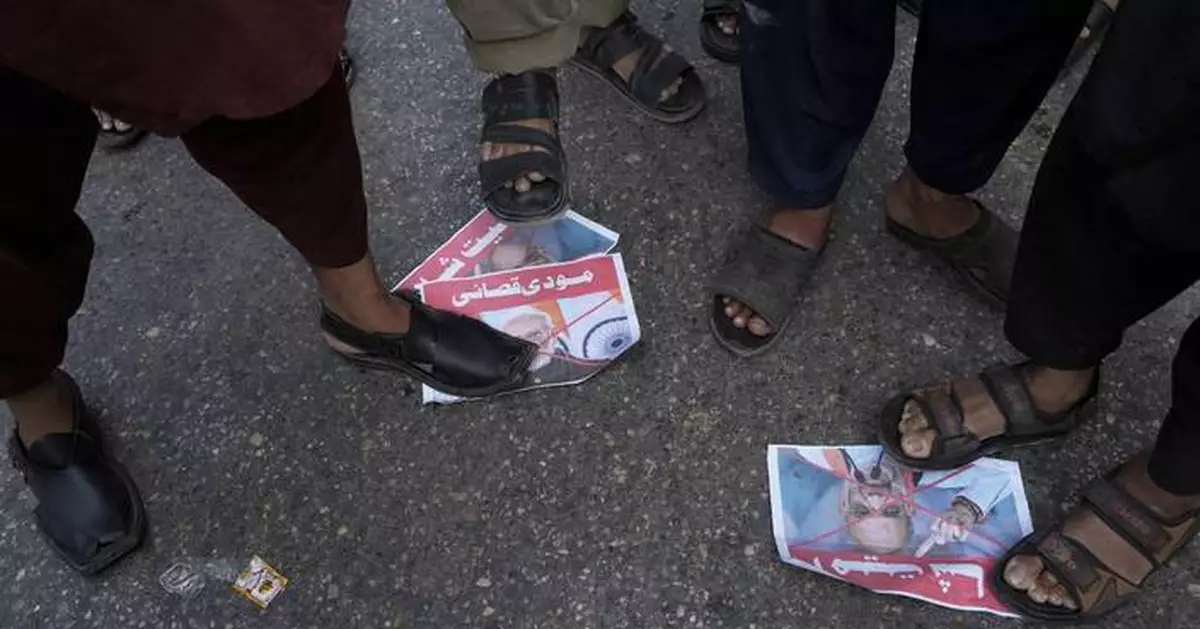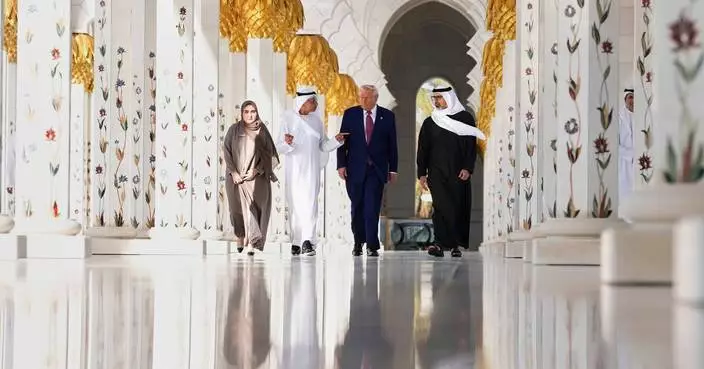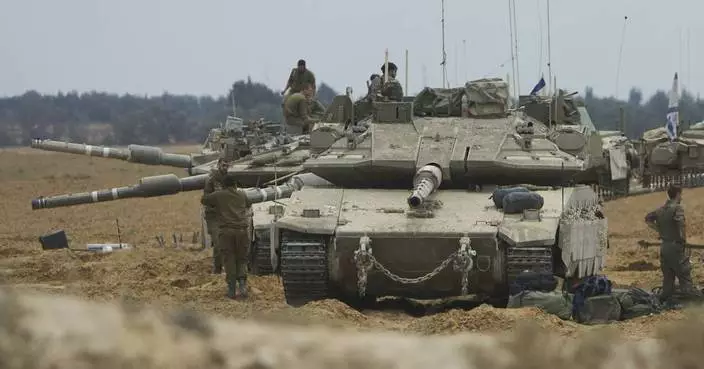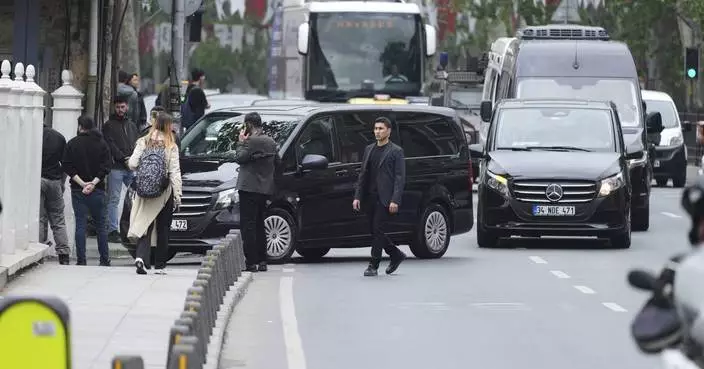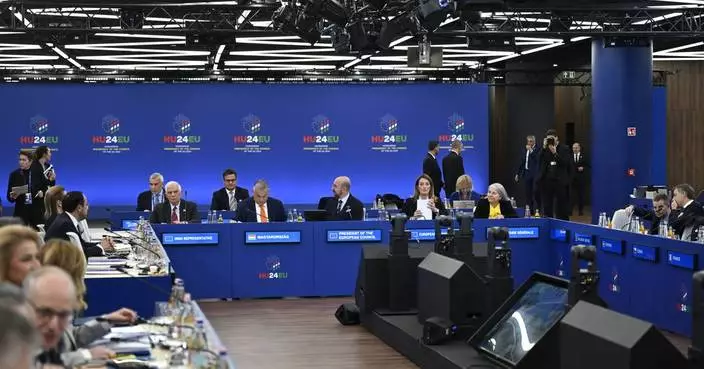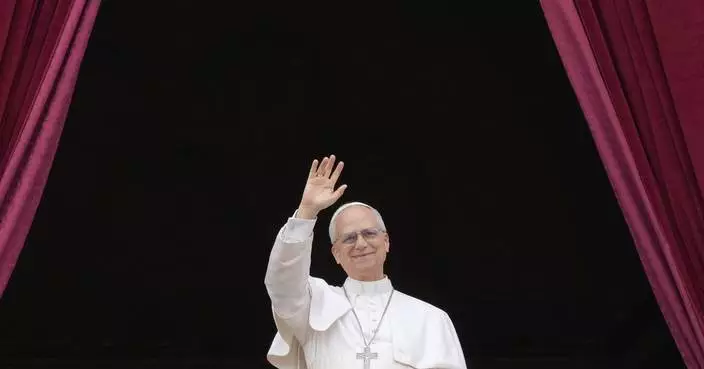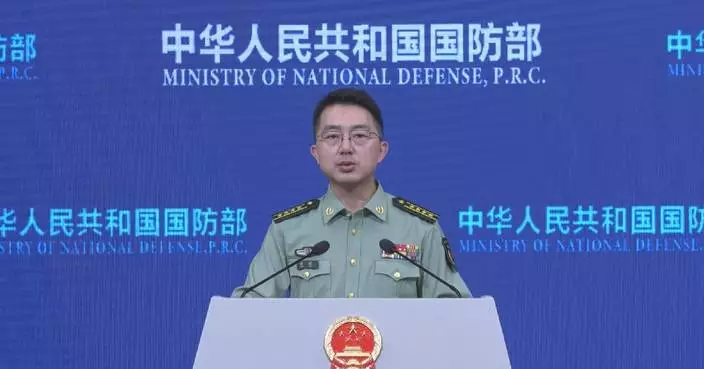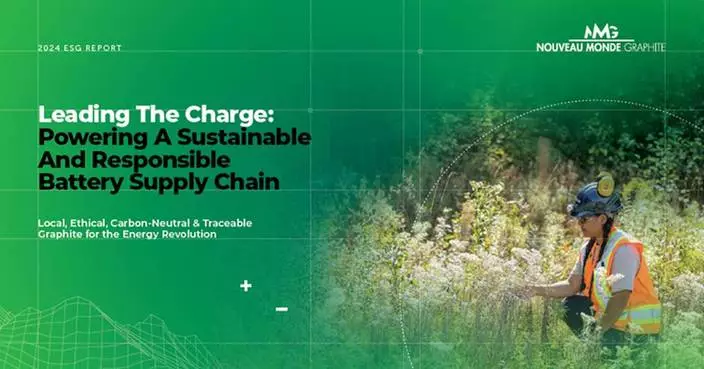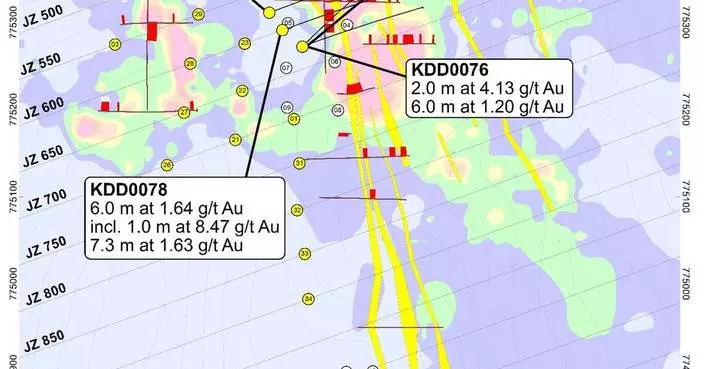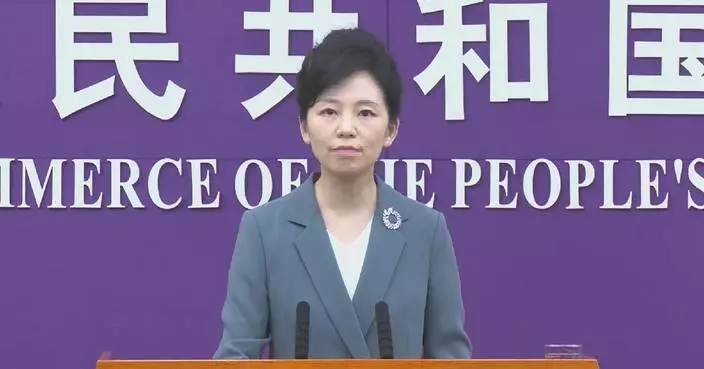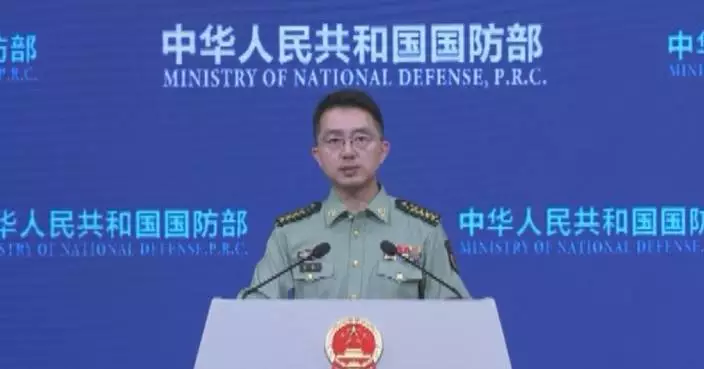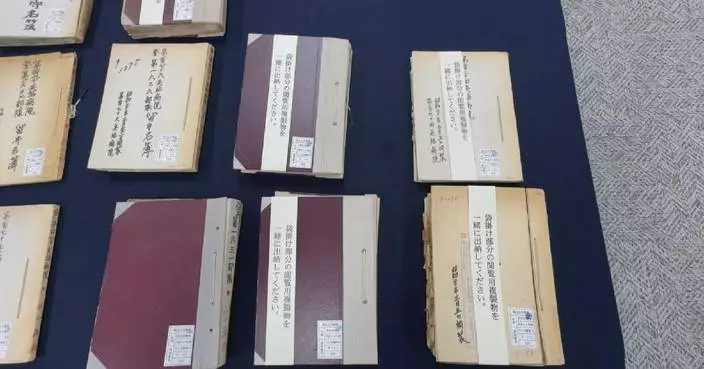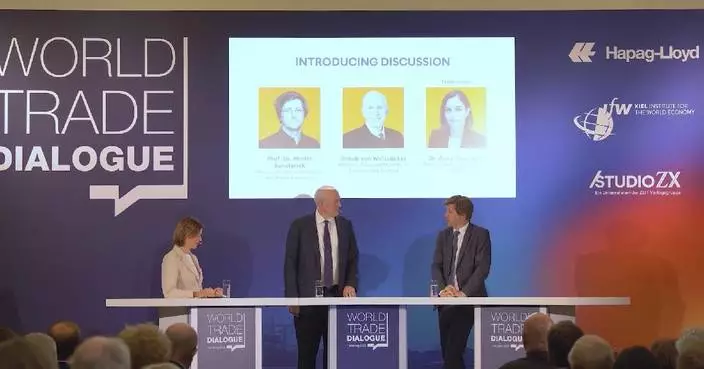NEW DELHI (AP) — A deadly attack on tourists in Indian-controlled Kashmir has again moved India and Pakistan closer to war as the two rivals downgraded diplomatic and trade ties, closed the main border crossing and revoked visas for each other’s nationals.
Pakistan has denied it was behind Tuesday's attack that killed 26 mostly Indian tourists at a scenic spot in the Himalayan region, where India claimed it restored a sense of calm despite a decadeslong rebellion. A previously unknown militant group calling itself Kashmir Resistance has claimed responsibility for the attack.
Click to Gallery
Kashmiri men hold candles and placards as they condemn the tourists killing during a protest in Srinagar, Indian controlled Kashmir, Thursday, April. 24, 2025. (AP Photo/Dar Yasin)
Kashmiri men hold candles and placards as they condemn the tourists killing during a protest in Srinagar, Indian controlled Kashmir, Thursday, April. 24, 2025. (AP Photo/Dar Yasin)
Pakistan's paramilitary soldiers stand guard at a checkpoint near Wahag, a joint border crossing point between the Pakistan and India border, Thursday, April 24, 2025.(AP Photo/K.M. Chaudary)
Supporters of the Pakistan Murkazi Muslim League party chants slogans during a demonstration against the suspension of water-sharing treaty by India with Pakistan, in Karachi, Pakistan Thursday, April 24, 2025. (AP Photo/Fareed Khan)
A supporter of the Pakistan Murkazi Muslim League party holds a crossed poster of Indian Prime Minister Narendra Modi with the words 'Modi butcher" during a demonstration against the suspension of water-sharing treaty by India with Pakistan, in Karachi, Pakistan Thursday, April 24, 2025. (AP Photo/Fareed Khan)
Supporters of the Pakistan Murkazi Muslim League party chants slogans during a demonstration against the suspension of water-sharing treaty by India with Pakistan, in Karachi, Pakistan Thursday, April 24, 2025. (AP Photo/Fareed Khan)
Supporters of the Pakistan Murkazi Muslim League party stand over the crossed posters of Indian Prime Minister Narendra Modi and Indian Minister of Home Affairs Amir Shah during a demonstration against the suspension of water-sharing treaty by India with Pakistan, in Karachi, Pakistan Thursday, April 24, 2025. (AP Photo/Fareed Khan)
India and Pakistan have fought two of their three wars over Kashmir, which is split between them and claimed by both in its entirety. Here's what to know about an escalation in tensions between the two nuclear-armed rivals.
Ties between India and Pakistan have been shaped by conflict, aggressive diplomacy and mutual suspicion, most notably in their competing claims over the stunning Himalayan region of Kashmir.
Armed insurgents in Kashmir have resisted New Delhi for decades, with many Muslim Kashmiris supporting the rebels’ goal of uniting the territory either under Pakistani rule or as an independent country. India accuses Pakistan of fomenting violence, a charge denied by Islamabad. Tens of thousands of civilians, rebels and government forces have been killed in the conflict over the years.
On Tuesday, gunmen fatally shot 26 people, mostly Indian tourists, in an attack near the picturesque town of Pahalgam. New Delhi immediately linked Pakistan to the attack, although it did not publicly produce any evidence.
India announced a string of punitive measures. It downgraded diplomatic ties, suspended a crucial water-sharing treaty and revoked all visas issued to Pakistani nationals. India also said it will reduce its staff in its high commission in Pakistan and bring down the number of Pakistani diplomats in New Delhi to 30 from 55 from May 1.
Pakistan called India's actions “irresponsible" and canceled visas for Indian nationals, suspended all trade with India including via third countries and closed its airspace to Indian aircraft.
India’s decision to suspend the water treaty could potentially mark a major turning point in how the two neighbors manage an essential shared resource between them. Pakistan warned Thursday that any Indian attempt to stop or divert the flow of water between them would be considered an “act of war.”
The Indus Water Treaty, brokered by the World Bank in 1960, allows for sharing the waters of a river system that is a lifeline for both countries. The treaty has survived two wars between the countries, in 1965 and 1971, and a major border skirmish in 1999.
It governs sharing of the water supply from the Indus River system and its distributaries. Under the treaty, India has control over the eastern rivers of Ravi, Sutlej, and Beas, and Pakistan controls the western rivers of Jhelum, Chenab, and Indus that follow through Kashmir region.
Pakistan said the treaty was binding and contained no provision for unilateral suspension.
Pakistan described it as a “vital national interest.” The treaty is essential for supporting agriculture and hydropower in the country with 240 million people. Suspending it could lead to water shortages at a time when parts of Pakistan are already struggling with drought and declining rainfall.
Islamabad, meanwhile, has warned it could suspend the Simla Agreement, a significant peace treaty signed after the 1971 India-Pakistan war that ended in Bangladesh splitting from Pakistan.
Under the agreement, India and Pakistan established the Line of Control, previously called the Ceasefire Line, a highly militarized de facto border that divides disputed Kashmir between the countries. They also committed to settle their differences through bilateral negotiations.
Despite largely strained relations, the neighbors have intermittently made efforts for peace. However, regular border flare-ups and multiple militant attacks in Kashmir and India have marred peace overtures as New Delhi has taken tough position on Islamabad, accusing it of “terrorism.”
In 1999, Pakistan-backed rebels and Pakistani soldiers seized Indian military posts in the icy heights of Kargil region. Indian troops responded and a 10-week conflict killed at least 1,000 combatants on both sides. The fighting stopped after a U.S. intervention.
In 2008, a group of heavily armed assailants of the Pakistan-based Lashkar-e-Taiba militant group went on a rampage in India’s financial capital Mumbai, killing 166 people. New Delhi blamed Pakistan’s intelligence service for the assault, an accusation denied by Islamabad.
In 2019, a suicide car bombing killed 40 Indian soldiers in Kashmir and brought the countries closer to war. In response, India said its air force struck a militant training camp inside Pakistan. Pakistan responded by aerial raids, downed an Indian military aircraft and captured an Indian pilot, who was later released.
Months later, Prime Minister Narendra Modi’s government revoked Kashmir’s semi-autonomous status and imposed sweeping security measures. Since then, India has kept order in the region with a huge security presence and drastically curbed dissent, civil liberties and media freedoms.
India and Pakistan have built up their armies and nuclear arsenals over the years. India was the first to conduct a nuclear test in 1974, followed by another in 1998. Pakistan followed with its own nuclear tests just a few weeks later. The sides have since armed themselves with hundreds of nuclear warheads, missile delivery systems, advanced fighter jets and modern weapons to take on each other.
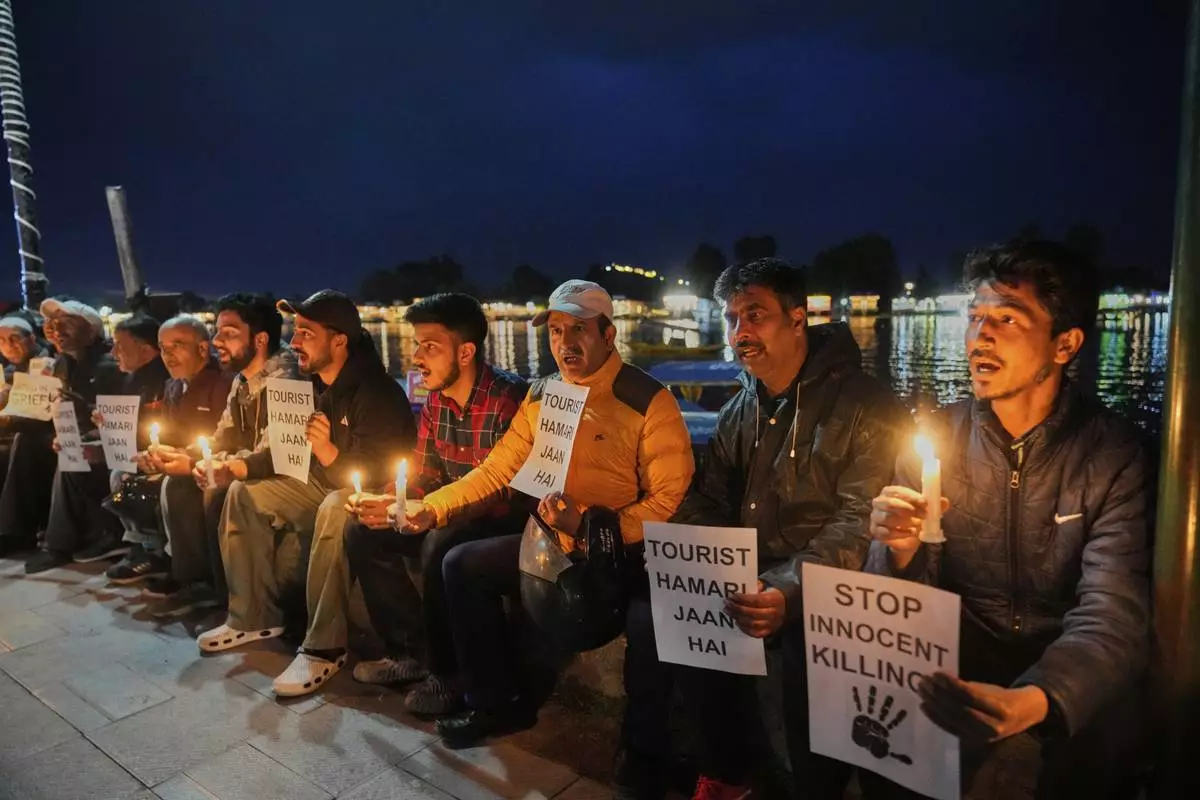
Kashmiri men hold candles and placards as they condemn the tourists killing during a protest in Srinagar, Indian controlled Kashmir, Thursday, April. 24, 2025. (AP Photo/Dar Yasin)
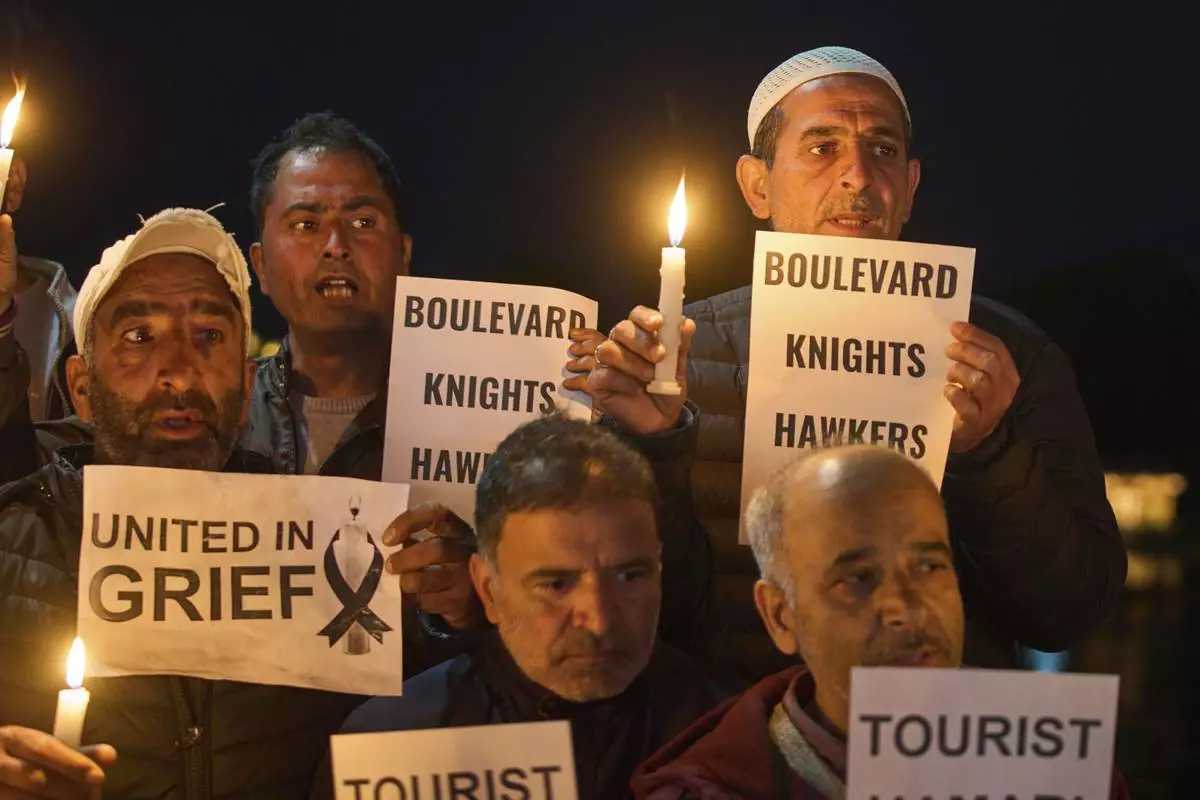
Kashmiri men hold candles and placards as they condemn the tourists killing during a protest in Srinagar, Indian controlled Kashmir, Thursday, April. 24, 2025. (AP Photo/Dar Yasin)
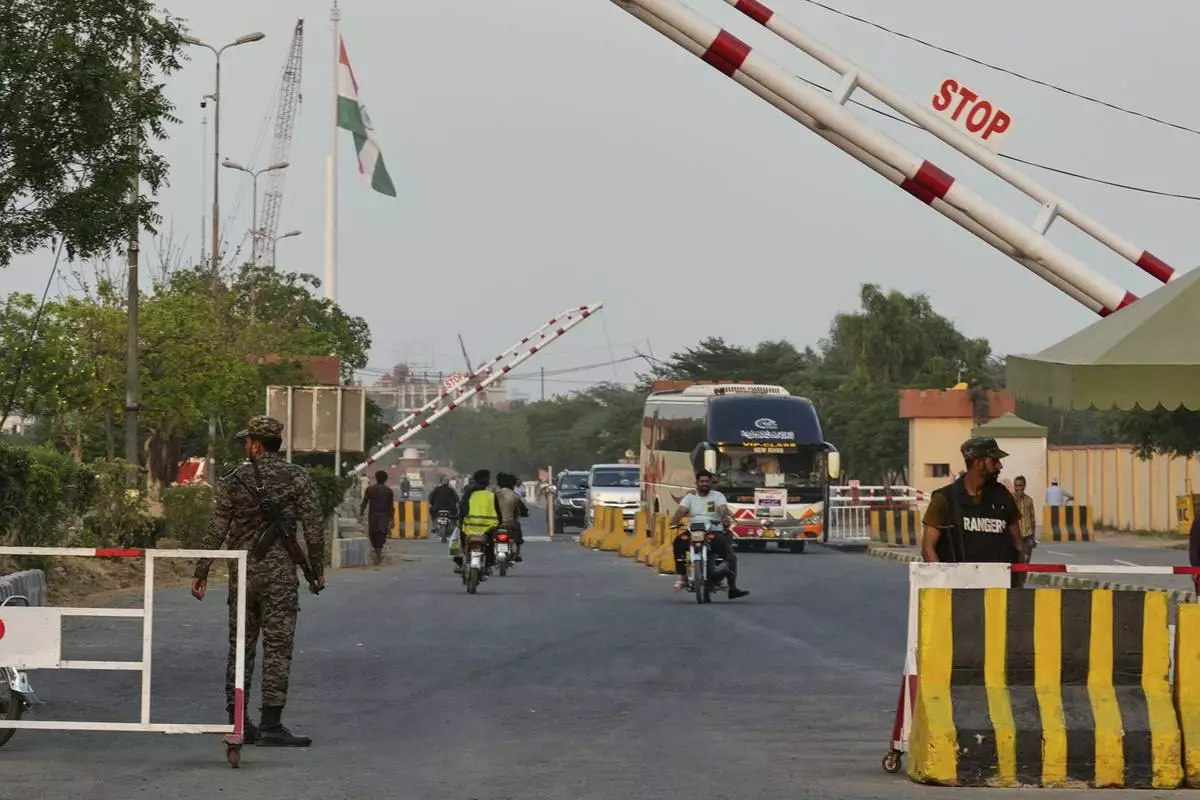
Pakistan's paramilitary soldiers stand guard at a checkpoint near Wahag, a joint border crossing point between the Pakistan and India border, Thursday, April 24, 2025.(AP Photo/K.M. Chaudary)
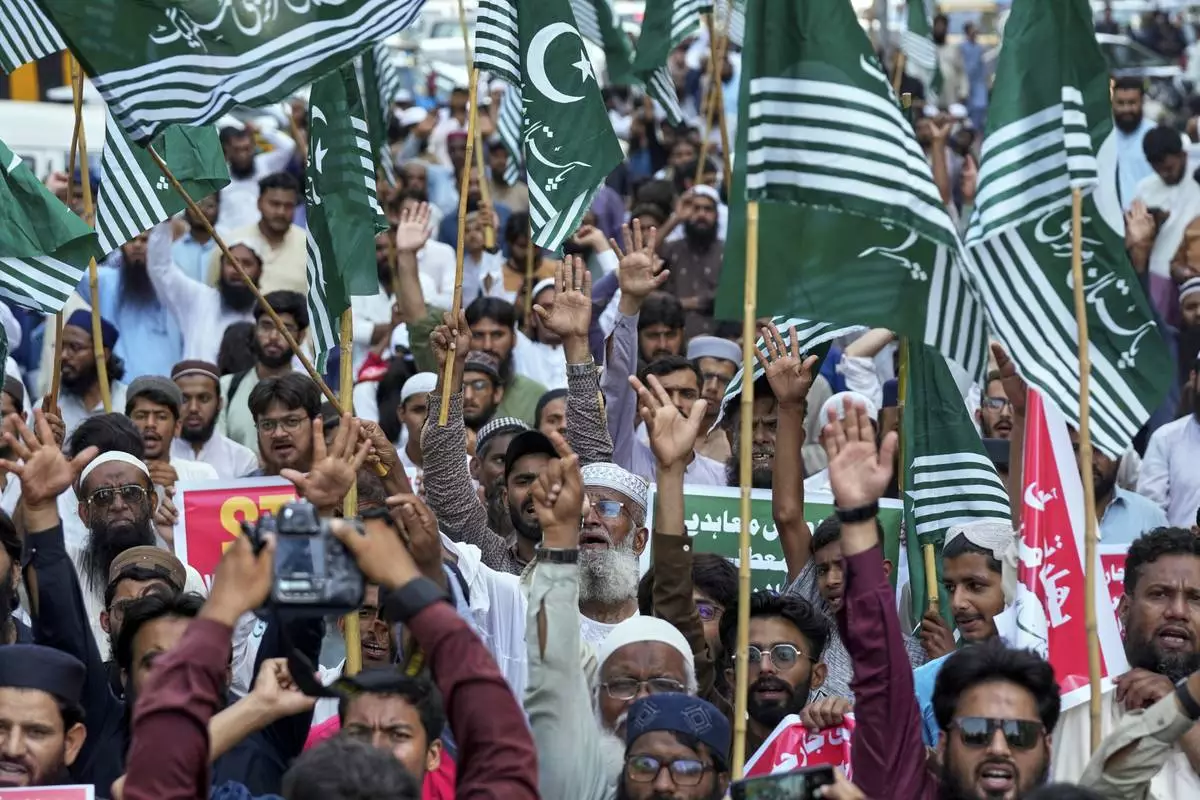
Supporters of the Pakistan Murkazi Muslim League party chants slogans during a demonstration against the suspension of water-sharing treaty by India with Pakistan, in Karachi, Pakistan Thursday, April 24, 2025. (AP Photo/Fareed Khan)
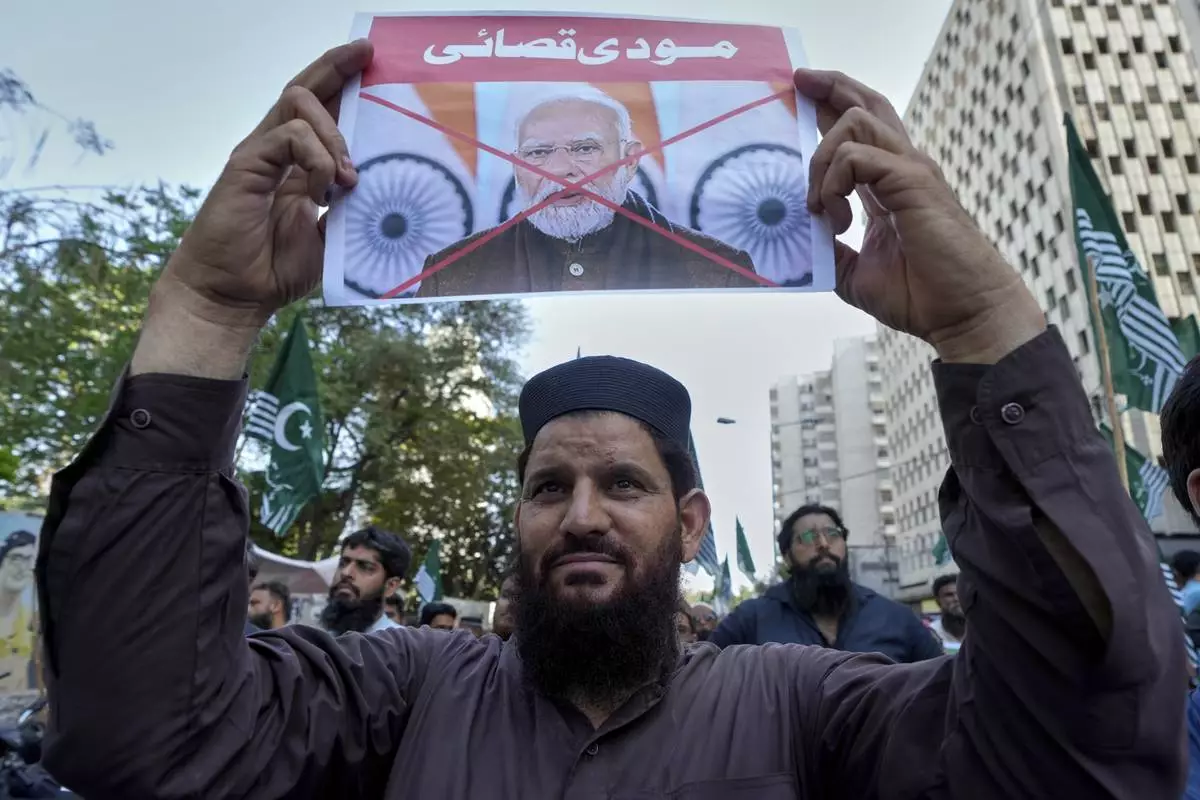
A supporter of the Pakistan Murkazi Muslim League party holds a crossed poster of Indian Prime Minister Narendra Modi with the words 'Modi butcher" during a demonstration against the suspension of water-sharing treaty by India with Pakistan, in Karachi, Pakistan Thursday, April 24, 2025. (AP Photo/Fareed Khan)
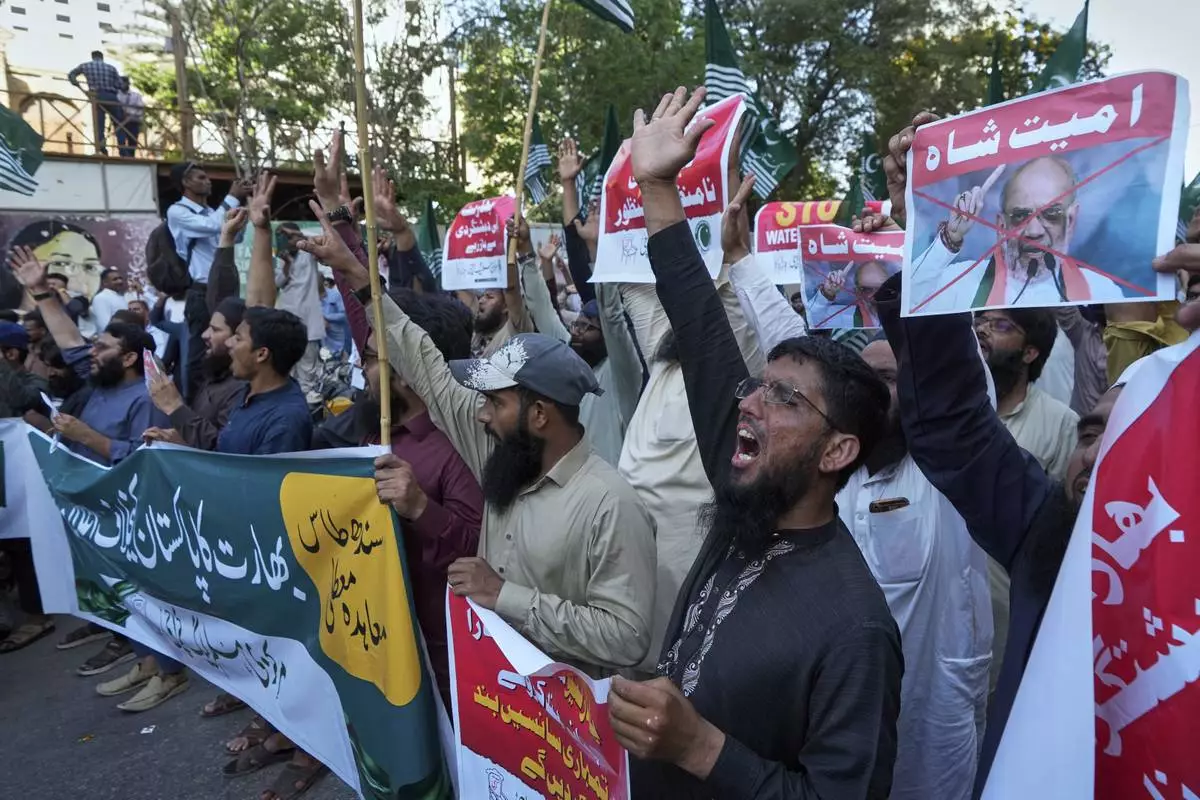
Supporters of the Pakistan Murkazi Muslim League party chants slogans during a demonstration against the suspension of water-sharing treaty by India with Pakistan, in Karachi, Pakistan Thursday, April 24, 2025. (AP Photo/Fareed Khan)
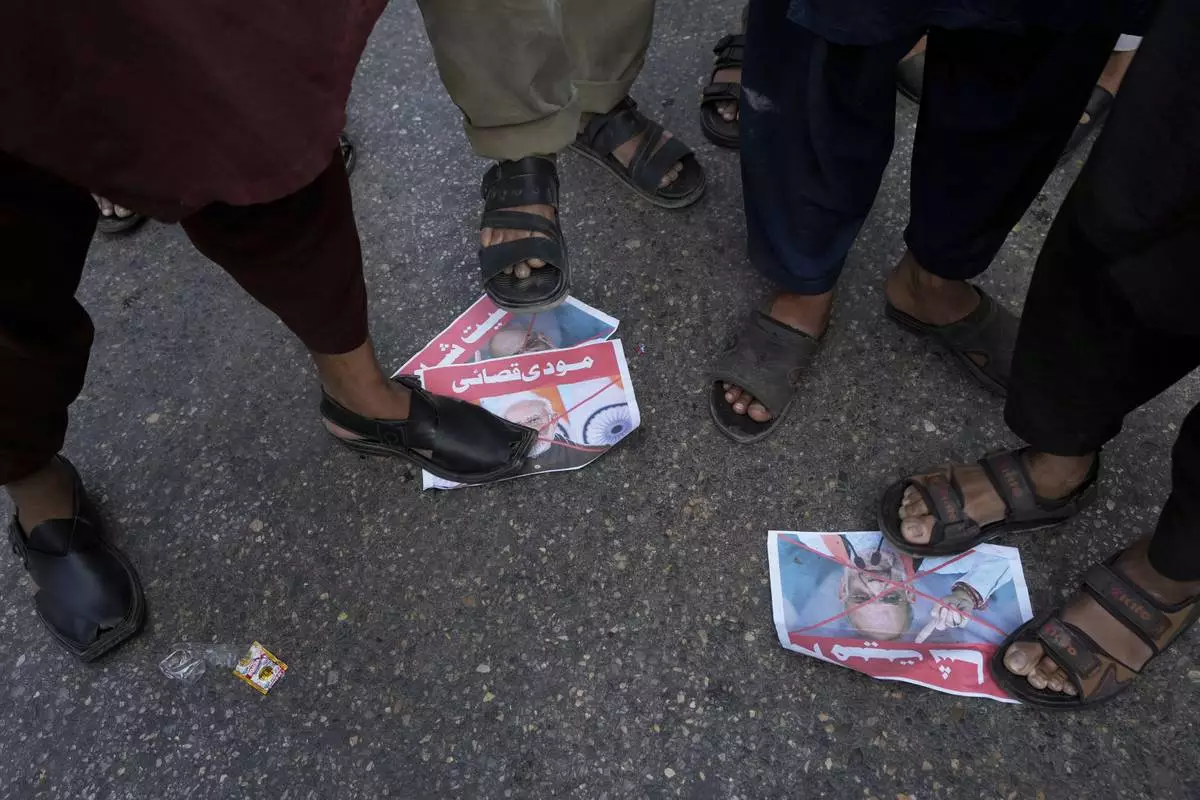
Supporters of the Pakistan Murkazi Muslim League party stand over the crossed posters of Indian Prime Minister Narendra Modi and Indian Minister of Home Affairs Amir Shah during a demonstration against the suspension of water-sharing treaty by India with Pakistan, in Karachi, Pakistan Thursday, April 24, 2025. (AP Photo/Fareed Khan)
ABU DHABI, United Arab Emirates (AP) — President Donald Trump used the first major foreign trip of his second term to outline a vision for restoring global stability that is grounded in pragmatism and self-interest rather than values, holding out U.S. ties to wealthy Gulf countries as a model for America’s longtime foes.
His four-day swing through Saudi Arabia, Qatar and the United Arab Emirates, which ends Friday, put a spotlight on Trump’s transactional approach to foreign affairs as he was feted by autocratic rulers with a trio of lavish state visits where there was heavy emphasis on economic and security partnerships.
His trip played out against the backdrop of stubborn global conflicts, including Gaza and Ukraine, that showed the limits of his influence. But Trump insisted he was turning the page on American “interventionalism” in the region as he moved to recognize the new government in Syria for the first time and prodded Iran to engage on nuclear talks before it’s too late.
Some takeaways from Trump’s travels:
Presidential trips to the Middle East usually feature at least some public calls for authoritarian governments to improve their human rights efforts. Not this one, as Trump celebrated his business deals with Gulf royals and admired their wealth.
Trump toured the marble and gilded palaces of Gulf rulers and deemed them “perfecto” and “very hard to buy.” He praised the “gleaming marvels” of the skyline in Saudi Arabia. And he groused about the “much less impressive” Air Force One.
In Trump’s remarks at a VIP business conference in Riyadh, he went out of his way to distance himself from the actions of past administrations, the days when he said American officials would fly in “in beautiful planes, giving you lectures on how to live and how to govern your own affairs.”
Rights advocates took that as a pledge of nonintervention, swearing off some of the pressure past U.S. presidents have brought to bear on partners to varying degrees to ease up on detentions, suppression of critics and other issues.
“It’s absolute support for absolute monarchy,” said Saudi exile Abdullah Alaoudh. His father, a Saudi cleric with a wide following there, is imprisoned in the kingdom.
Some rights advocates said Trump officials gave them private assurances the administration was working on behalf of detained Americans and rights advocates. Tommy Pigott, a deputy spokesman at the State Department, declined to say whether Trump raised those or other rights issues in discussions with Gulf royals.
While Trump was in the Mideast, Vladimir Putin opted to skip direct peace talks with Ukraine’s Volodymyr Zelenskyy despite the U.S. president's strong calls for them to meet face to face.
Trump has been pushing Putin and Zelenskyy to move with greater haste to end Russia's grinding war in Ukraine.
But after it became clear Putin wouldn’t be attending talks in Turkey this week and would instead be sending underlings to Istanbul, an annoyed Trump insisted he knew all along that it was highly likely Putin would be a no-show.
“I don’t believe anything’s going to happen whether you like it or not, until he and I get together,” Trump said. “But we’re going to have to get it solved because too many people are dying."
As he wrapped up his visit on Friday, Trump said the face-to-face would happen "as soon as we can set it up.”
Trump was scheduled to fly back to Washington on Friday, but tried to keep people guessing until the end. He teased late Thursday that he would be heading to a “destination unknown” — “probably" Washington, he added. His opaque language stoked speculation that he might make a drop-by to Turkey.
But on Friday morning, he told reporters he needed to get back to Washington. His daughter Tiffany had her first child while the president has been away.
“I would actually leave here and go,” Trump said. “I do want to see my beautiful grandson.”
Just two months ago, the Trump administration wasn’t sold on Syria’s interim government led by Ahmad al-Sharaa, the onetime al-Qaida-affiliated insurgent. They worried the Syrian president didn’t have the legitimacy to govern the country’s ethnically diverse population.
Clashes broke out in early March, killing hundreds and targeting many more members of the Alawite religious minority to which the ousted Syrian leader Basher Assad belongs.
The moment gave the Trump White House pause about easing sanctions on Syria. But Trump signaled Monday that he was having a change of heart and was moving toward lifting the Syria sanctions. A day later, he announced the move during an address to Gulf leaders.
Trump then took it another step by agreeing to meet al-Sharaa.
Trump said he was impressed with al-Sharaa, who not that long ago had a $10 million U.S. bounty on his head. The president called him a “young, attractive guy” with a "very strong past.”
Trump said it was recommendations from Turkish President Recep Tayyip Erdogan and Saudi Crown Prince Mohammed bin Salman that nudged him to take a chance on al-Sharra.
“President Erdogan called me and said: ‘Is there any way you could do that? Because if you don’t do that, they don’t have a chance,’” Trump said. “So, I did it.”
Throughout the trip, Trump felt more than comfortable dishing out exaggeration and hyperbole.
“This has been an amazing trip.” Trump told reporters Thursday as Air Force One was about to land in Qatar. “We’ve raised trillions of dollars of investment for our country.” A little later he put the figure at $4 trillion.
That figure is about two times the combined gross domestic products of Saudi Arabia, Qatar and the United Arab Emirates, meaning that any announced investments would likely accrue over several years — if at all — in ways that might not show up in overall U.S. economic growth numbers.
Boeing confirmed that Qatar’s $96 billion purchase of its 787 and 777X jets was the largest order for 787s and wide body jets in the company’s history. Trump enthused it was “the biggest order in the history of, I think, aviation, certainly of that size” of jets.
Trump also went overboard in running down the economic record of his predecessor, Democrat Joe Biden, at one point declaring, “The days of economic misery under the last administration are rapidly giving way to the greatest economy in the history of the world.”
The U.S. economy grew at 2.8% last year. It declined at an annualized rate of 0.3% during the first three months of this year.
While Trump's trip initially was conceived as a visit to reward countries that invest in the United States, Trump at one point hoped it also would herald significant steps to end the wars in Gaza and Ukraine. Positive news on both fronts proved elusive.
Trump barely mentioned either conflict on his trip – and when he did, it was generally in the context of his assertion that they wouldn’t have occurred had he won reelection in 2020.
As Israel stepped up an offensive in Gaza — a prelude to a promised full takeover of the territory if Hamas doesn’t release the remaining hostages in its captivity — Trump was again musing about the creation of a “freedom zone” in its territory. It's a notion rejected by Palestinians and the broader Arab world because Trump's plan would relocate civilians from Gaza to allow for rebuilding.
Israel conducted significant airstrikes all week in Gaza as Trump was in the region and the fighting on the ground appeared to escalate Friday morning even before Trump left the UAE.
Trump was already facing questions about conflicts of interest for traveling to the Middle East to shape U.S. policy at a time when his family’s business interests in the region have boomed. He attempted to quiet worries about national security and constitutional questions by insisting he’s smart to accept a $400 million luxury plane from Qatar and use it as Air Force One.
“Why should our military, and therefore our taxpayers, be forced to pay hundreds of millions of Dollars when they can get it for FREE,” Trump posted on his social media site during his Middle East swing.
The president also dodged questions about a state-backed investment company in Abu Dhabi using a Trump family-aligned stablecoin for a $2 billion investment in the world’s largest cryptocurrency exchange.
“I don’t know anything about it,” he said.
Beyond that, the Trump family has piled up deals to license its brand for real estate projects, and to build Trump towers and golf courses, around the Middle East. White House press secretary Karoline Leavitt says it’s “frankly ridiculous” to wonder if those profits might influence Trump’s governing decisions.
Madhani reported from Dubai. Associated Press writers Josh Boak, Will Weissert and Ellen Knickmeyer in Washington contributed to this report.
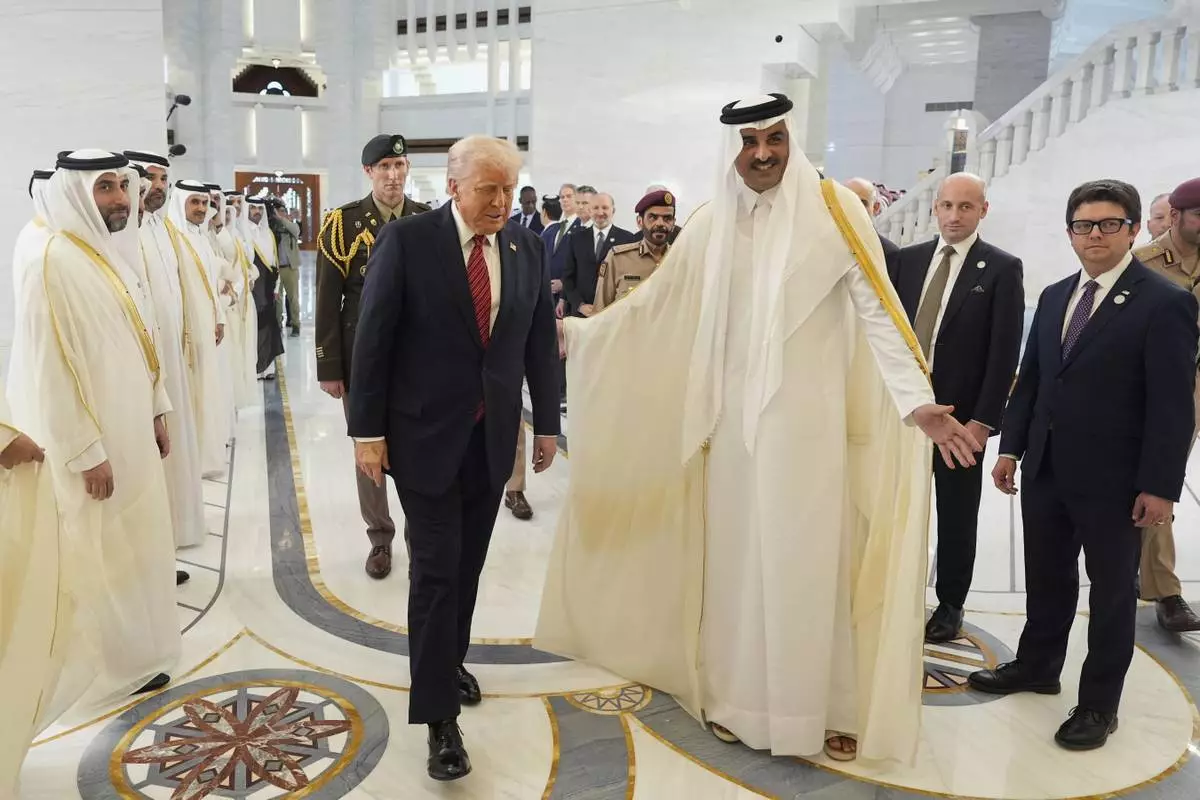
Qatar's Emir Sheikh Tamim bin Hamad Al Thani welcomes President Donald Trump during an official welcoming ceremony at the Amiri Diwan in Doha, Qatar, Wednesday, May 14, 2025. (AP Photo/Alex Brandon)
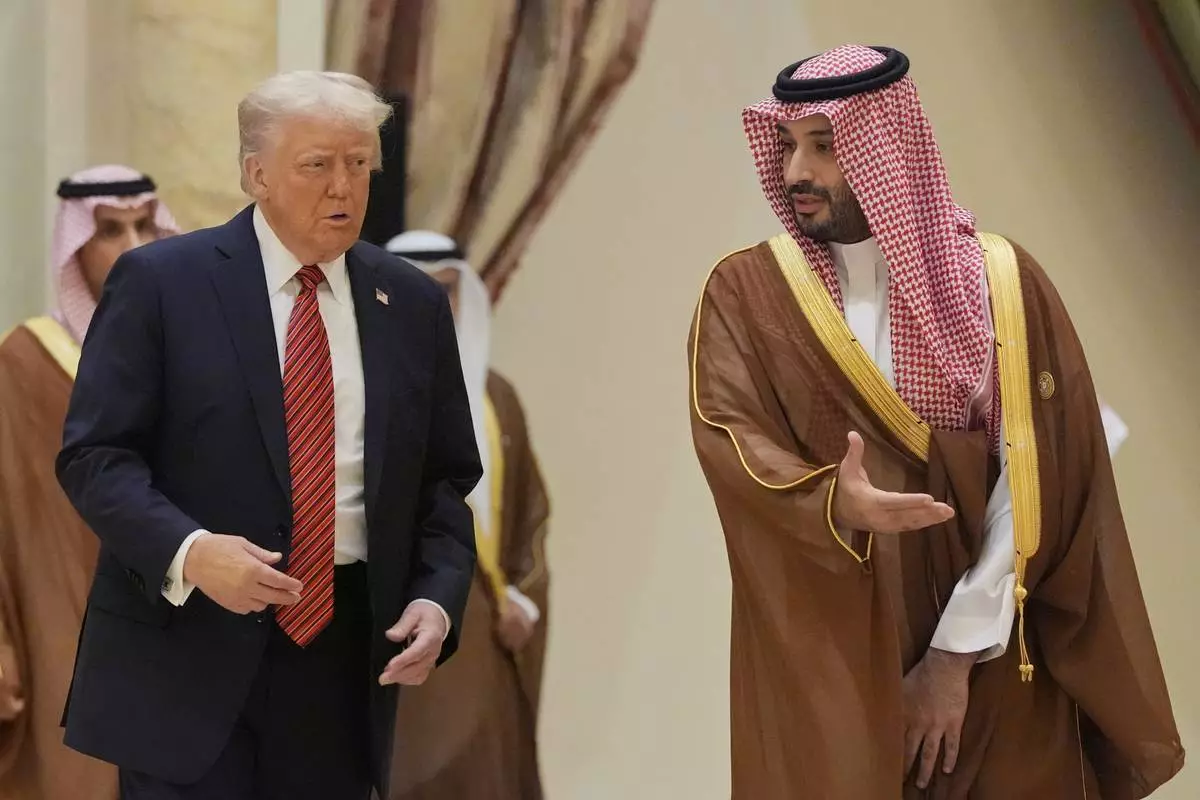
President Donald Trump arrives with Saudi Crown Prince Mohammed bin Salman for the group photo with Gulf Cooperation Council leaders during the GCC Summit in Riyadh, Saudi Arabia, Wednesday, May 14, 2025. (AP Photo/Alex Brandon)
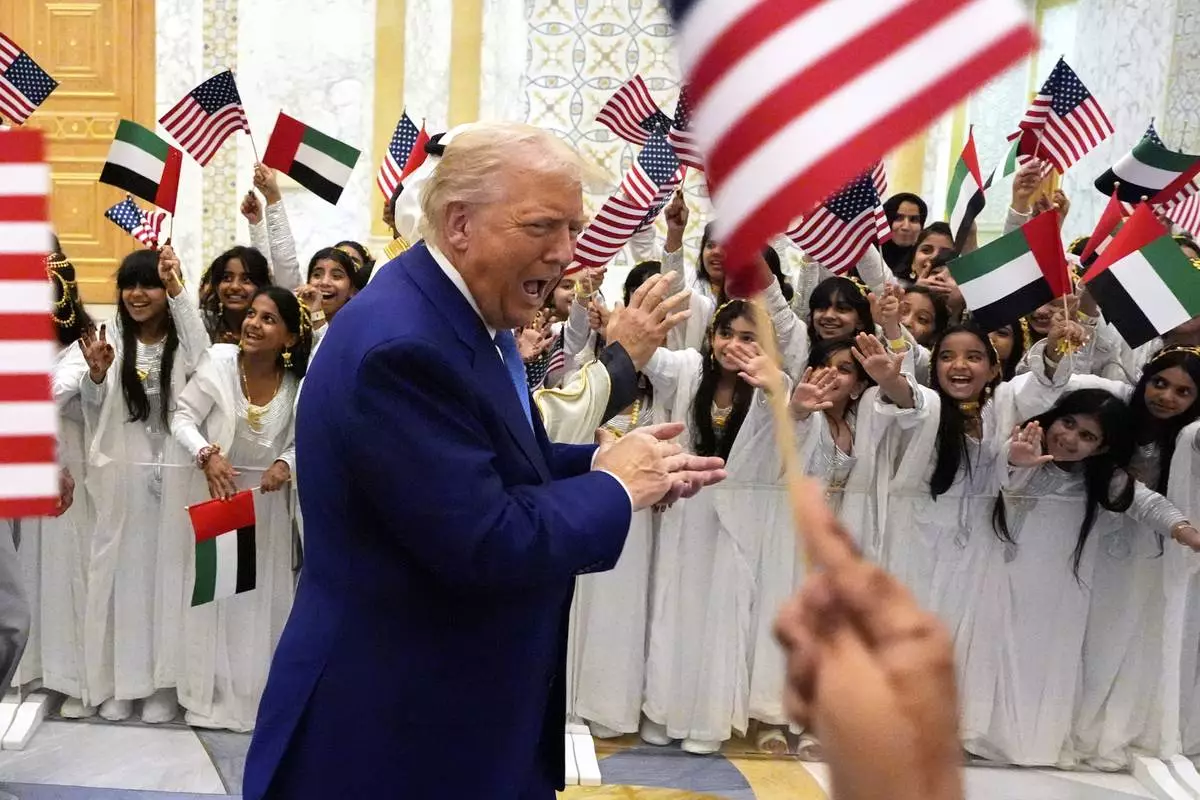
President Donald Trump and UAE President Mohammed bin Zayed Al Nahyan arrive at Qasr Al Watan, Thursday, May 15, 2025, in Abu Dhabi, United Arab Emirates. (AP Photo/Alex Brandon)









